Forget wilderness. It doesn’t exist, and it never did.
That phrase popped into my head while on the phone with Tyson Atleo, hereditary chief-in-line of the Ahousaht Nation, talking about the Ahousaht Stewardship Guardian Program in what most sea kayakers call Clayoquot Sound, but has been called Ahousaht Hahoulthee for millennia. It’s one of the most popular sea kayaking destinations in North America, and one of my favorite places in the world. And it’s part of a sea of change coming to west coast sea kayaking.
Why wilderness kayaking is nonsense
I was chatting with Tyson about the Guardian Program, which collects voluntary stewardship fees from paddlers, outfitters and other users of their traditional territories. The funds are put to work in salmon restoration, trail clearing, studying kelp beds, restoring campsites and running youth programs for tribal members.
My conversation with Tyson came while I was planning a sea kayak trip to the west coast of Vancouver Island. With Flores Island closed to protect the Ahousaht from Covid-19, my friends and I started looking at other parts of Vancouver Island. We found some places we’d camped in past years had shifted to no camping, or the information was unclear. Delving into it, I found changes in land management had come to much of Vancouver Island’s coast as many First Nations have negotiated treaties and other measures with the Canadian and British Columbian governments providing for self-governance and a greater role in managing their traditional territories, including the Ahousaht Hahoulthee. In the U.S., the Land Back movement to return land to Indigenous people to own or manage has also been gathering steam.
View this post on Instagram
“One of the challenges during the transition period is each Nation is approaching it differently, based on their treaty situation and the use pattern, and that can make it hard for those looking for universal information. “It’s essential there are diverse approaches,” says David Pinel, former co-owner of West Coast Expeditions, who recently sold the well-known tour company to the Ka:’yu:’k’t’h’-Che:k:tles7et’h’ First Nations (anglicized as Kyuquot—Checleset, pronounced “kie-you-kit”-“check-le-set”). There’s a new Guardian Stewardship team in their territory too, called Witwaak.
As treaties and land management evolve, kayakers can expect more stewardship efforts and more cultural awareness. And yes, some culturally significant spots will probably be closed to recreational visitors. Word to the wise: Call the First Nations whose territory you plan to visit, if you can’t find current information. Change is in real time, and what’s open to paddlers this season may be different next year.
The changes in camping, fees and a boat coming around are small potatoes. A good friend who loves the solitude of long paddling trips and doesn’t like to run into other groups mentioned the boat coming around would “break the wilderness vibe.” Time for a reality check: wilderness is nonsense. It’s time to ditch the concept entirely.
After writing that sentence, I can see the torches and pitchforks already. So, let’s be clear: I love nature. My day job is running a river conservation group. As it happened, I ended up canceling that kayak trip to work on removing a dam so a river can flow free. But wilderness, with a capital W, is bunk.

Far from a wilderness untrammeled
The Wilderness Act, a linchpin of protecting nature in the U.S., defines Wilderness as “an area where the Earth and its community of life are untrammeled by man, where man himself is a visitor who does not remain.”
In addition to forgetting 50 percent of humans are women, the Wilderness Act chose to overlook that humans had been living in the places we set aside as wilderness areas. If they weren’t, it was because they’d been killed by disease or removed by conquest or genocide. No fewer than 26 tribes were actively living in Yellowstone National Park when it was created.
“It’s the doctrine of discovery,” Atleo told me, “that white people discovered an uninhabited landscape.” Doctrine is too kind a word. A better word starts with the name for a male cow. The only one to see a “wilderness untrammeled” was the first one across the Bering Land Bridge.
If I paddled my yellow NDK Explorer into a wormhole and came out on the west coast a millennia ago, I wouldn’t see what most think of as wilderness: empty beaches with only tracks of wolves and bears. “If you saw a beach that was inviting to land on, chances are it was a seasonal or year-round location for a significant family group or more through several millennia and still of cultural significance,” Pinel told me. Far from paddling off to escape civilization, I’d be paddling into a complex, thriving one. There would have been much negotiation about whether and where I could land and pitch my tent.
Paddlers can benefit from new perspective
As First Nations and Native Americans play a larger role in land management, the rest of us have a shot at a richer and smarter way of experiencing the places we visit than the “Wilderness” nonsense.
Instead of thinking of land in black-and-white simplicity—wilderness versus civilization, outdoor recreation versus extractive industries, paddling vacation versus work—let’s see our landscapes for what they truly are: complex natural systems in which humans are a part, and where we will either repair the landscape or keep damaging it. The sale of West Coast Expeditions is one step in that direction. In addition to seeing a thriving coastal ecology, it’s a natural way for visitors to learn about the Ka:’yu:’k’t’h’-Che:k:tles7et’h’ people.
“There is an increasingly strong appetite for visitors to feel like they’re connecting with local people and culture and doing the right things—their own version of reconciliation,” Pinel says.
Another part of reconciliation is making sure money from tourism goes to improve the lives of First Nations people. Stewardship fees funding things like bear boxes, toilets, habitat restoration and beach cleanups are a common sense investment in sustainable paddling. More importantly, they’re a way to finally redirect the economic benefits of what has been euphemistically called “unceded” (read: stolen) lands. It only takes one visit to the end of Highway 4 to spot the contrast between the weathered buildings of Opitstat and Marktosis and Tofino’s upscale restaurants and luxury “wilderness resorts.” There’s that word again.
So, if it’s not wilderness we’re seeking when we paddle off the beach, what is it? Wildness? Reconnecting?
I don’t have the perfect word for a thriving ecology that includes human civilizations, offers respite from the mayhem of everyday life, acknowledges past wrongs, welcomes everyone and builds a future that sustains both humans and the natural world.
Tyson Atleo had started our conversation by explaining the first guiding principle of the Ahousaht—Hishook-ish Tsawalk: Everything is one.
That’ll work.
Neil Schulman lives in Portland, Oregon, the traditional land of the Multnomah, Kathlamet, Clackamas, Chinook, Tualatin Kalapuya and Molalla people. He still loves places with fresh air, scenery and lots of critters.
It might feel like you’re the first person to ever paddle this way, but you’re not. | Feature photo: Brendan Kowtecky





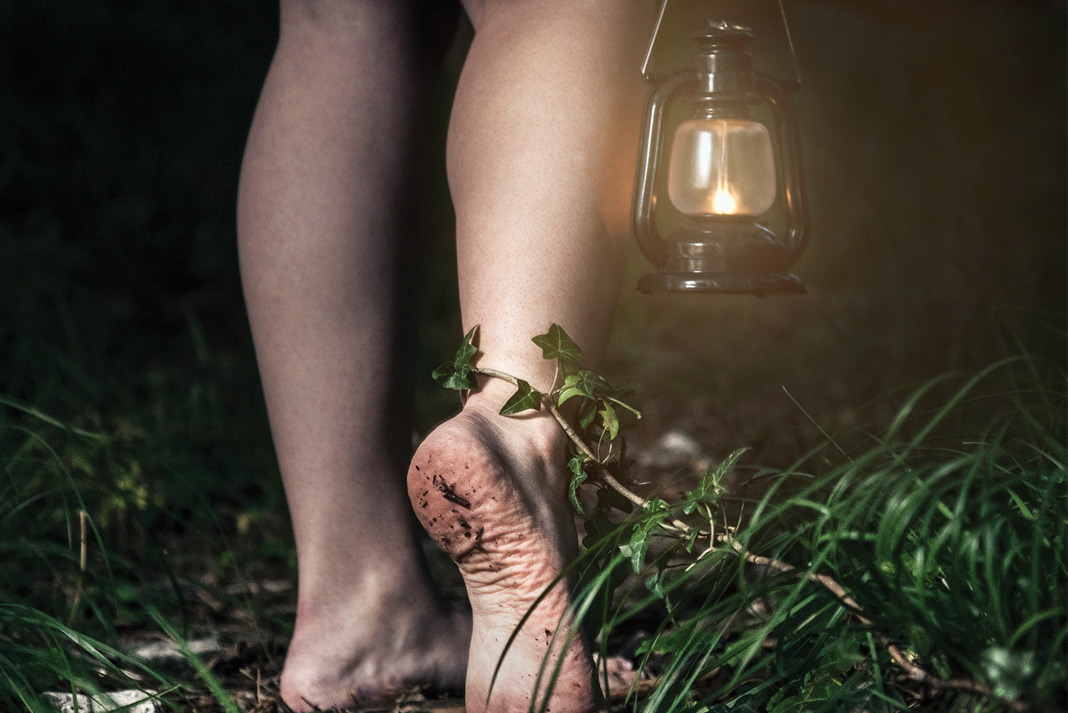
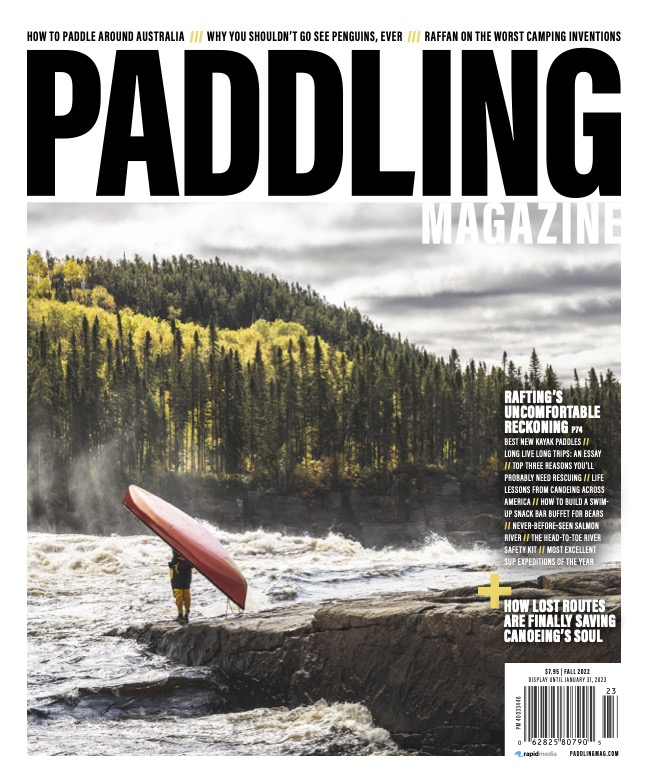 This article was first published in the Fall 2022 issue of Paddling Magazine.
This article was first published in the Fall 2022 issue of Paddling Magazine. 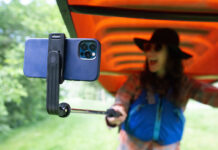
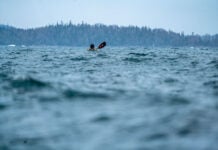
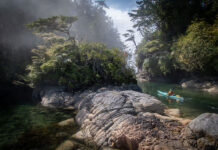
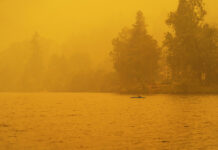
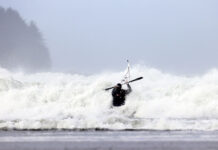

Excellent, timely, provocative article. Thanks for writing and sharing. There is small w and big W wilderness, but as an Indigenous person once told me, “We just consider this place HOME.” Perhaps we should talk about what we’re really looking for — which is Wildness, and healthy functioning ecosystems.
When a statement refers to “man” it is not male or female, it is “human”. As far as the land bridge thing, people went back and forth over that area, it was not how this continent became populated. I have many justifiable reasons for this along with many native teachings. If you ever want to discuss this feel free to contact me.
Wilderness should be defined as a process and not a state of being. The state of being should only be considered an ideal, something that makes a sort-of magnetic field to be used as guidance toward the ideal. But it is the movement toward that ideal and not the ideal itself that classifies Wilderness. Read Aldo Leopold’s Sand County Almanac: “A thing is right if it tends to preserve . . .” No mention of being preserved.